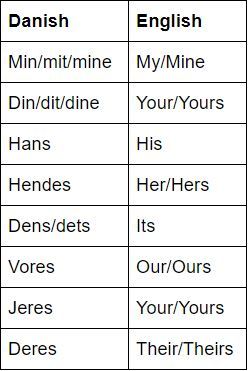#hendes
Check out this lesson at danishwithemi.com
Is it mine? Is it yours? Is it Marie’s? Let’s extend on our knowledge about possessions and possessive pronouns in Danish. First, a quick recap of the possessive pronouns that we saw in Lesson 6:

What’s the difference between “min/mit/mine”, “din/dit/dine” and “dens/dets” you might wonder. Let’s look at the difference:
Min/mit/mine
Min is used when the object you are talking about is an en-noun (e.g. “en kat”).
- Example sentence: Det er min kat = It is my cat
Mit is used when the object you are talking about is an et-noun (e.g. “et fjernsyn”).
- Example sentence: Det er mit fjernsyn = It is my television
Mine is used when the object you are talking about is in plural (e.g. “bøger”)
- Example sentence: Det er mine bøger = It is my books
Din/dit/dine
Din is used when the object you are talking about is an en-noun (e.g. “en kat”).
- Example sentence: Det er din kat = It is your cat
Dit is used when the object you are talking about is an et-noun (e.g. “et fjernsyn”).
- Example sentence: Det er dit fjernsyn = It is your television
Dine is used when the object you are talking about is in plural (e.g. “bøger”)
- Example sentence: Det er dine bøger = It is your books
Dens/dets
Dens is used when the owner of an object is an en-noun. Let’s say that the object is a toy and that the owner is a cat. You could then say: “It is the cat’s toy”. But you could also replace the word “cat’s” with “its” and the sentence then becomes: “It is its toy”. Since a cat in Danish is an en-noun (en kat), the word “its” translates to “dens” (and not “dets”) in Danish. The sentence in Danish is then:
- Det er dens legetøj = It is its toy
Dets is used when the owner of an object is an et-noun. Let’s say that the object is a garage and that the owner of the garage is a house (yes, this example is weird). You could then say: “It is the house’s garage”. But you could also replace the word “house’s” with “its” and the sentence then becomes: “It is its garage”. Since a house in Danish is an et-noun (et hus), the word “its” translates to “dets” (and not “dens”) in Danish. The sentence in Danish is then:
- Det er dets garage = It is its garage
‘s
To show possession in English ‘s is used. For example: “It’s my mom’s car”. The concept of adding an s at the end of the word is the same in Danish. However, the apostrophe is omitted. The sentence in Danish would then be: “Det er min mors bil”
- Example sentence: Det er Marias hun = It is Maria’s dog
Sin/sit/sine
Sin/sit/sine wasn’t part of the table above because they are quite special. Their grammatical purpose was already covered in Lesson 6, but for good measure I will leave the same explanation here:
In English there’s no difference between the pronoun used when the subject of a sentence is owning the object of a sentence versus when the subject of a sentence is not owning the object of a sentence. This sounds like gibberish, but let’s look at an example sentence:
- He eats his burger.
In this example sentence you can’t tell whether he is eating his OWN burger or some other guy’s burger. This is something you will have to know from context of the sentence.
In Danish there’s a clear distinction between whether (as in this example) he is eating his own burger or someone else’s. Let’s look at the same example but in Danish:
- Han spiser sin burger. (since the pronoun “sin” is used we can tell that he is eating his own burger)
- Han spiser hans burger. (since the pronoun “hans” is used we can tell that he is eating someone else’s burger)
Sin is used when the object of the sentence is an en-noun (e.g. “en far”).
- Example sentence: Hun besøger sin far = She visits her dad
Sit is used when the object of the sentence is an et-noun (e.g. “et æble”).
- Example sentence : Hun spiser sit æble = She eats her apple
Sine is used when the object of the sentence is in plural (e.g. “katte”)
- Example sentence: Hun kæler for sine katte = She pets her cats
If you have any questions or feedback feel free to submit a question/feedback at danishwithemi.tumblr.com/ask and I will answer as soon as possible.
